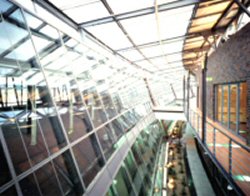Glass and Human Impact

Glass in its annealed form, framed and in tact is not an immediate threat but when it is broken the long shards turn into effective cutting devices with sharp edges and momentum. Fortunately glass can be modified to change these properties and reduce the risk of injury dramatically. There are standards and codes of practice that state where impact resistant glass must be used but the list of locations is not exhaustive. Anywhere where there is a risk of human contact should be evaluated for the potential risk of breaking glass.
Generally glass is considered a risk in areas of low level glazing and in and around doors. The risk locations are the areas where accidental damage may cause the glass to break. Another risk area is where glass may be loaded to a high level due to the pressure applied by bodies as in the case of glass floors and barriers. In floor and barrier locations the contact wih the glass will be predicted rather than by accident. A further area of interest is overhead glazing where the integrity failure of glass may have dire consequences unless the glass is modified. Glass used in furniture should also comply with the safety requirments for tables, cabinets, shelves and glass doors to wardrobes etc.
The most frequently used glass used to improve personal safety is toughened andlaminated glass products. Rarely do we suggest a combination of toughened and laminated glass because it can give the poorest chracteristics of both glasses.
Toughened glass achieves its impact resistance by having the strength increased by a factor of upto 5 and when it breaks it collapses into small relatively harmless particles.
Laminated glass is no stronger than the annealed glass it is formed from but the interlayer bonds the panes together. The bonded panes resist penetration and holds the broken panes together reducing the risk of harm.
Glass is categorised for its impact resistance in BS6206 and BS EN 12600.